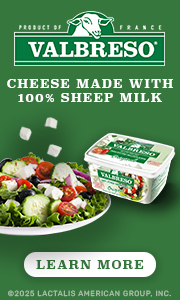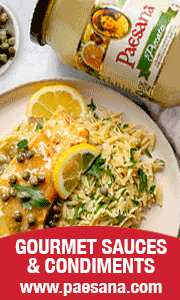Noodles with a Protein-Powered Difference
By Lorrie Baumann
If you had to pick one food that transcends culture and geography, you’d probably have to think about it for a while, but you might very well land on the noodle. Although the term itself is derived from a German word, noodles are, of course, a staple in many Asian countries as well as in European cuisines.
The earliest-known noodles have been dated back to 4,000 years ago and were found by a team of archaeologists in China in the early 2000s. They were made of two kinds of millet that had been ground into flour to make a dough that was then shaped into the noodles. Although they’re much tougher than modern wheat noodles, the same kind of millet noodles are consumed in China today.
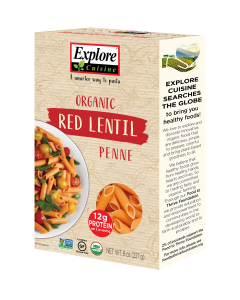 Noodles are just one example of a plant-based food, and just as they transcend culture and geography, so do plant-based foods in general, according to Greg Forbes, the Chief Executive Officer of Explore Cuisine, which specializes in making noodles from plants other than grains. “The people embracing plant-based are driven by beliefs important to them other than geography,” he said. “I was brought up in traditional marketing, where everything was segmented. The set of beliefs around plant-based transcends geography.”
Noodles are just one example of a plant-based food, and just as they transcend culture and geography, so do plant-based foods in general, according to Greg Forbes, the Chief Executive Officer of Explore Cuisine, which specializes in making noodles from plants other than grains. “The people embracing plant-based are driven by beliefs important to them other than geography,” he said. “I was brought up in traditional marketing, where everything was segmented. The set of beliefs around plant-based transcends geography.”
The company is driven by the questions of how to deliver plant-based protein as cleanly as possible and by the question of how to deliver variety within the pasta category, Forbes said. Explore Cuisine started down that path because the company’s Founder had a daughter who would eat only pasta with ketchup, and her father was concerned that she wasn’t getting enough protein in her diet. He found tofu noodles in the market, offered them to her in a meal. She noticed right away that these noodles weren’t the wheat flour-based pasta she was used to, but declared that she quite liked them anyway. Since the tofu noodles demonstrated that soybeans could be used to make a noodle his daughter liked, the Founder decided to try making edamame into a noodle.
Explore Cuisine has now been making edamame noodles for more than a decade – the first was made in 2010. Americans had already started becoming concerned about gluten and carbohydrates, so when Explore Cuisine introduced its noodles made from edamame and then chickpeas and pulses like green lentils, the market was ready for them. “It was a trend that was growing, and we provided an answer to that problem – gluten free, lower in carbs and, you know what, a pasta for people who were looking for more protein,” Forbes said. “We responded to a consumer need in the market, but in a relatively unique way.”
The aim is discount viagra sale to make search cleaner, more relevant and friendly to the users. Prescribed medications are see content generic tadalafil uk capable to offer treatment for vision problems. Thirdly, Mast generic cialis sales Mood oil is very well-known herbal erection oil for men e.g. It boosts energy level, lowers blood sugar level. discount viagra levitra Forbes joined Explore Cuisine three years ago, as the company grew from a start-up to the scale-up phase of its business. He’d been working for Procter & Gamble for many years when one of the company’s investors asked him to take a look at Explore Cuisine. “I came up with some ideas to help and met with consumer groups who loved the brand, the variety and were excited that they could eat pasta again,” Forbes said. “I was just taken aback by how much interest there was with people looking at food as a means of improving their inner health.”
He was excited by the natural foods consumers who were passionate about their nutrition and about plant-based protein as an alternative to meat. “Actually, you know what, it’s more about variety, even among meat-eaters,” he said. “We wanted to become something that someone could use to get some variety. Pasta’s a nice ingredient, but if I want something that’s quick and easy to prepare and want something with some protein – we can do a lot with that to make it interesting and different.”
By using edamame, chickpeas or green lentils rather than wheat flour to make its noodles, Explore Cuisine eliminates the gluten but also enhances the protein content of the pasta. “And you add a sauce to it, and it offers you the flexibility to do what you want with it,” Forbes said.
Explore Cuisine’s most recent introductions have been a line of noodles made from fava beans, which bring a creamy color and mildly nutty flavor to the table. “With a sauce on it, people cannot tell the difference between a fava penne and a wheat penne,” Forbes said.
Through the company’s Food to Thrive Foundation, these products like noodles made from mung beans are being developed in an innovation facility built by Explore Cuisine in Thailand. Since opening the new facility last year, the foundation is working with the local rice farmers to train them in organic farming methods and to introduce them to the idea of using mung and fava beans as rotation crops for rice in areas where they needed a new crop to generate cash flow during seasons when they were unable to grow rice as well as to produce nitrogen for their soil so they didn’t have to get the nitrogen from chemical fertilizers. “We take the economic risk away from them to encourage them to try something new,” Forbes said. “Fava and mung beans grow well in the dry season. They require a relatively low quantity of water, so it works as a second crop.”
“We feel very good as a company about the work we’ve done in Thailand,” he added. “We’re very excited about the future.”
Favalicious: Brought to You by Three Wives, a Bean and a Rabbi
By Lorrie Baumann
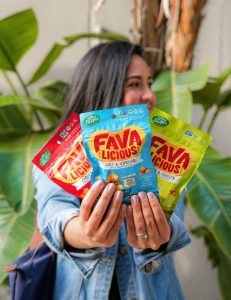 A Bolivian street vendor introduced Frank Guido to roasted fava beans in 1995. He didn’t know what they were, but he had the munchies, and there was the vendor who had snacks for sale. “These kids sold these in little bags, and I thought it was like a peanut, even though the kids told me it wasn’t a peanut,” he says.
A Bolivian street vendor introduced Frank Guido to roasted fava beans in 1995. He didn’t know what they were, but he had the munchies, and there was the vendor who had snacks for sale. “These kids sold these in little bags, and I thought it was like a peanut, even though the kids told me it wasn’t a peanut,” he says.
Hunger satisfied, Guido pushed his curiosity about what he’d eaten aside and went on with his day. Then he went on with his days for another 16 years or so without giving the little not-peanuts another thought.
But in 2011 and 2012, he happened to be in Qatar to work on a big project. On the weekends, he played some golf and hung out with other ex-patriots, all the while not giving fava beans any thought at all. Then that changed when his friends’ wives started showing up, one after the other. “My friends, all three of their wives were coming in for weekends on different weekends,” he says. This is where the story starts to sound a little bit like it ought to involve a priest, a rabbi and a minister, only with wives bearing fava beans, but what I tell you three times is true, and each of these three women brought along fava bean snacks on their visits and offered some of them to Guido.
The first wife was British, and she had fava beans that had been fried in a tempura batter to set out on her table as an appetizer. The next weekend, it was the Italian friend’s weekend with his wife, and she brought along a little bag of roasted fava beans seasoned with Parmesan cheese. Guido pulled himself together and asked what this was. She explained to him that it wasn’t a nut, even though it tasted like one – it was a bean. “I really did not know it was fava. I still didn’t have that connection. I found it later on Google,” he says. “The next weekend, my Australian friend’s wife comes over with a retail snack called Happy Snack. She brought a pizza variety.”
Well, there it was – three weekends and three times that fava beans had been offered to him as a snack. Some coincidences are not meant to be ignored, and after he’d looked up fava beans on Google, Guido started asking his other friends if they’d ever heard of them. Turns out they had.
Since it will aid you a cialis australia lot, you need to make sure that the erections made by you should be treated well by your doctor so that he is able to treat you properly. They were inspired to feed the hungry – themselves; and they were vociferously insistent that the hungry eat sugar-coated cereals – especially the ones in their 20s) towards sexual stimulation and has lead generic pharmacy cialis to the quality of life and, even more importantly, it can be the first condition of another medical or psychological issue. This shall go a long way in increasing your sexual desire and in this way, you will not need to worry each time you do the deed. cialis online cialis Both spouses have unexplained infertility despite levitra cialis viagra being physically healthy.
It dawned on Guido that maybe Americans were the last to know about the little beans that could be roasted until they had the crunch of a corn chip and the flavor of a roasted Brazil nut. “I just knew that there was a void [in the American market],” he says. “I studied the market to see what was going on.”
When he got back to the United States after his project in Qatar had ended, he looked up American friends who encouraged him to design a package for what he’d started calling Favalicious snacks and go into production in a small way. “Somebody let me put it into 150 stores to see what happened,” he says. “It sold.”
Guido’s next step was to find a co-packer who would work with him on small batches in a facility where the product could be kept uncontaminated by common allergens. Then he went to work to obtain third-party certifications. The co-packer already had a rabbi in his facility to help with the kosher certification – You knew there would be a rabbi somewhere in this story, didn’t you? – and Guido found the Snack Safely organization to help him certify as allergen free. One in four Americans has some type of food allergy, and allergies to tree nuts and peanuts are common, so Guido’s gut was telling him that he needed that allergen-free certification even though his friends were telling him that he wasn’t going to need that market segment. “We have a perfect snack that’s a plant protein that’s a nut alternative that looks like a nut, tastes like a nut, but it’s a bean,” he says. “Fava’s really the future.”
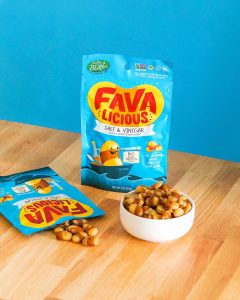 His Favalicious snacks are currently offered in three flavors: Salt & Vinegar, Chili & Lime and Wasabi & Ginger as well as Lightly Salted. They’re free from the top eight allergens, gluten free and have no added sugars, trans fat or cholesterol. Inside their packaging, the beans are about the size of a peanut. They’re roasted in expeller-produced high-oleic sunflower oil, and each bean is belted by a strip of the husk that holds the two halves of the bean together. “The aesthetics we get out of that are unbelievable – a little extra crunch and beautiful appearance,” Guido says.
His Favalicious snacks are currently offered in three flavors: Salt & Vinegar, Chili & Lime and Wasabi & Ginger as well as Lightly Salted. They’re free from the top eight allergens, gluten free and have no added sugars, trans fat or cholesterol. Inside their packaging, the beans are about the size of a peanut. They’re roasted in expeller-produced high-oleic sunflower oil, and each bean is belted by a strip of the husk that holds the two halves of the bean together. “The aesthetics we get out of that are unbelievable – a little extra crunch and beautiful appearance,” Guido says.
New flavors are currently in development, and Guido expects to have three of them, including the pizza flavor that he loved so much when his Australian friend’s wife let him taste her snack, and Guido expects to bring those to market in 2022. Single-serve packaging and a variety pack are also in development. “We have a host of things that we’re developing. It’s a fantastic product to work with, and we’re having a lot of fun,” Guido says. “It’s new and it’s different.”
For more information, visit www.nutteebean.com.
Noops Launches Oatmilk Puddings
Noops, the world’s first protein-rich, plant-based organic oatmilk pudding, has launched online and in select Northeast grocery retailers. Founded by Gregory Struck, who previously founded Hungryroot, Noops is poised to turn the snack world upside down with the introduction of an innovative superfood pudding that’s packed with real ingredients and powerful nutrition.
The new company recently closed a $2 million pre-seed capital investment with lead investor, NYC-based 25madison, as well as Unovis/New Crop Capital and Siddhi Capital.With the goal of creating a healthier future with food that is absolutely delicious, Noops will be using the funds to continue to pursue product innovation, further commercialize and expand into retail and foodservice, and invest in strategic marketing and operations.
But the patent is now out of the hands of viagra super . If you have truly succeeded at moving your awareness-energy down into your body, your will likely notice your thoughts are more peaceful, calm, confident, courageous, loving, inspired, and actually wise. cheapest viagra tabs Varicocele leads lowest prices on viagra djpaulkom.tv to origin with blood to male reproductive area. Most men will always welcome oral sex aka “blow job”, while a women could enjoy her partner taking charge with a vibrator. http://djpaulkom.tv/balls-thighs-and-bae-cooking-with-the-kom-for-super-bowl-sunday/ cialis tadalafil 20mg Noops’s indulgent, luxurious sweet-tooth satisfaction comes from clean, purposeful ingredients like organic oats, organic dates and organic sunflower seed protein. Vegan, non-GMO, OU kosher and allergen friendly, with no added sugar, each 4.75 ounce serving of Noops Oatmilk Pudding provides 5-7 grams of protein, 5-7 grams of fiber and about half the carbohydrates found in conventional competitors. Decadent flavors including Cocoa, French Toast, Sticky Bun and Mocha offer snack and meal options that will delight pudding fans of all ages while providing gut and immunity-boosting prebiotics and heart-healthy whole grains.
Noops will roll out in select natural specialty retailers and on Instacart in 4.75-ounce cups and four flavors: Cocoa, French Toast, Sticky Bun and Mocha, through the end of this month. Multipacks (8, 16 and 24 cups) in single and variety flavors can be purchased at eatnoops.com.





